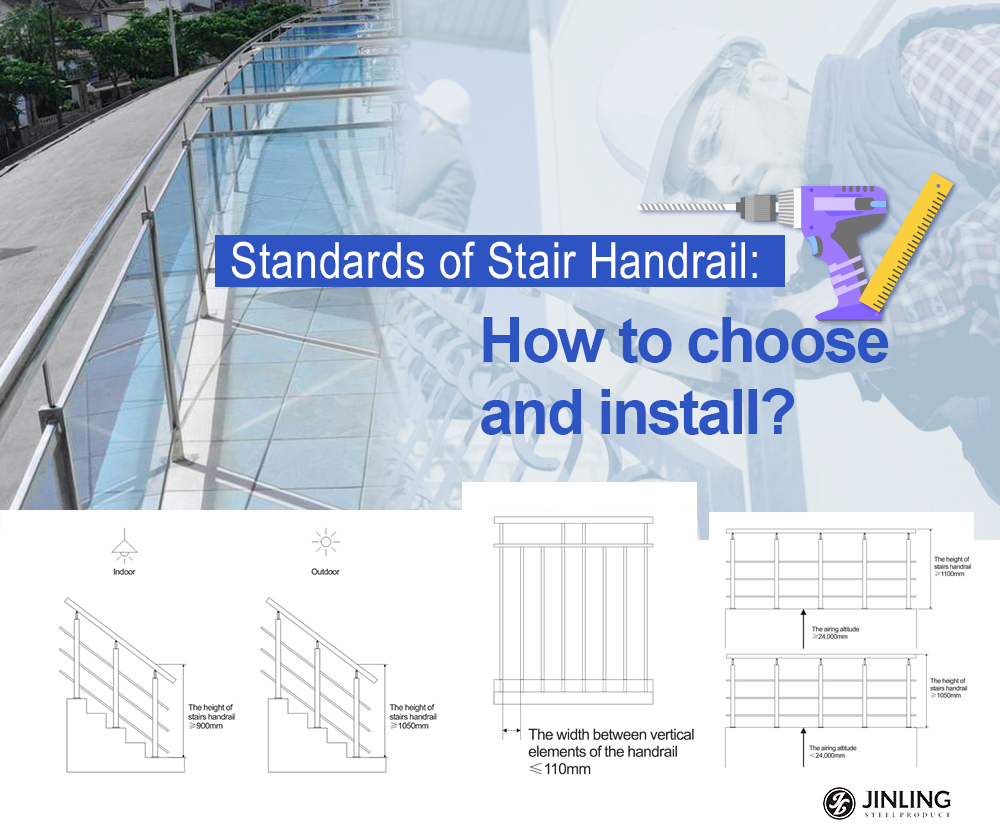The stair is common in our daily life. It is the main access connecting between floors and buildings. Considering safety, typically for the elders and kids, it is necessary to install stair handrails. Stair handrail is a bracket of stair guardrail. In the market, there are stair handrails made of steel, stainless steel, glass, and wood, etc..
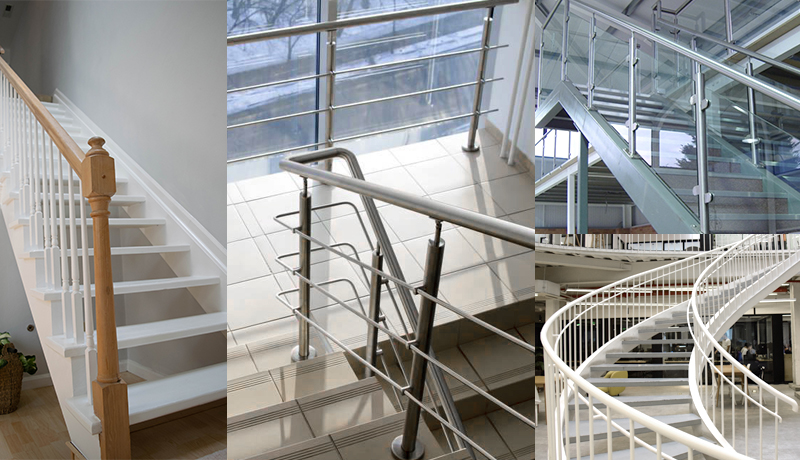
1. Dimensions of stair handrail
a. The indoor handrail height, measured vertically from the edge of the tread shall be not less than 0.9m; the height of the outdoor stair handrail shall be more than 1.05m.
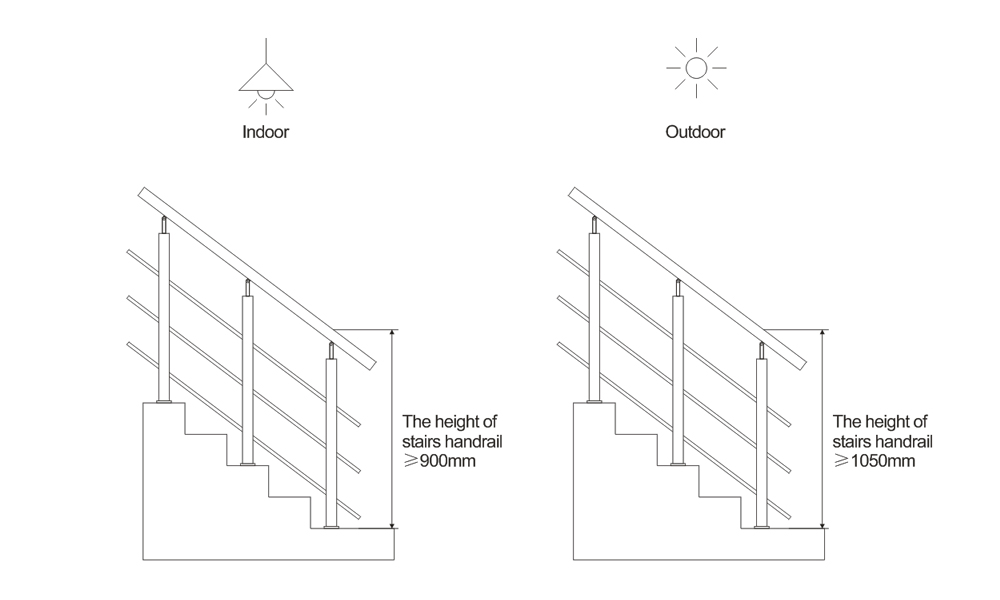
b. When the stairwell width is greater than 0.20m, the width of the vertical element of the handrail shall be greater than 0.11m to prevent the child from falling.
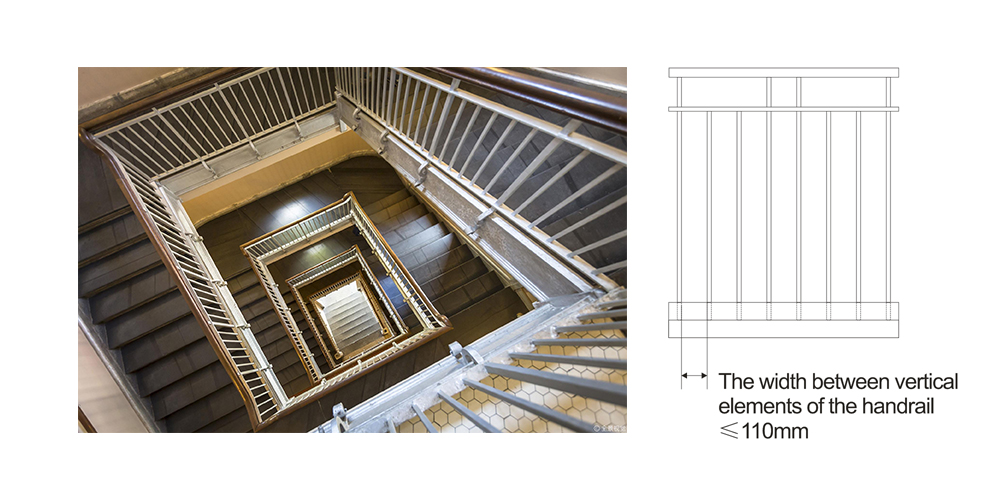
c. The stair landing in clear width shall not be less than the width of stairs and in the meantime, the former shall be greater than 1.10m in net width.
d. The width of the stairs is regulated by building codes. On any occasion, stairs should meet the requirement of the fire evacuation. As for stairs in the public buildings, the width is usually greater than the regular standard. Besides, the number of handrails is based on the width of the stairs. For example, in normal cases, stairs should have handrails on at least one side; for stair serving three users, handrails must be provided on both sides of the stair; for four simultaneous persons walking on the stair, the stair should have an extra intermediate handrail.
2. The height of stair handrail
Protective stairs should be located in the balcony, veranda, indoor corridor, inner courtyard, accessible roof, indoor stair and other vacant places, which should be consistent with the following stipulations:
a. Stairs should be made of solid and endurable materials, which are capable to bear the prescriptive load;
b. When the airing altitude is under 24m, the height of stair handrails should be greater than 1.05m. When the airing altitude reaches 24m or above, including middle or high rise residents, the minimal height of stair handrails should be not less than 1.10m;

c. There shall not have openings if the stairs are 0.10m from the walking surface.
d. In public places that allow children to enter, such as schools, buildings for culture and entertainment, commercial buildings, sports buildings, and gardens, the stair handrails should be constructed to prevent the youth and kids from falling. If using vertical elements to build the stair guardrails, the gap should be less than 0.11m.
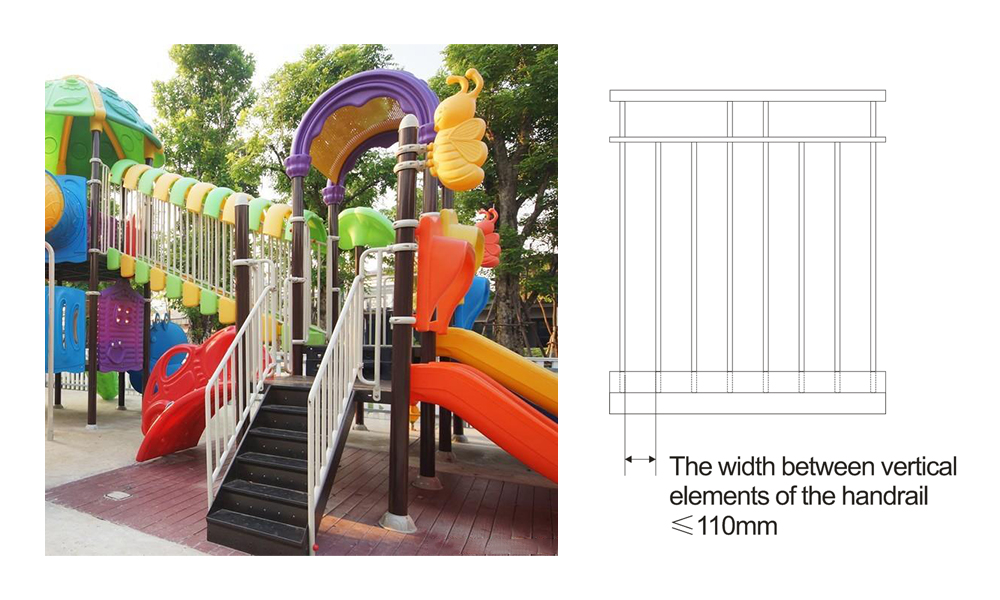
e. The standard height of the indoor stair handrail is 90cm, but it can be changed according to the actual circumstances. If the length of stair surpasses 5m, the stair handrail height shall be increased to 100cm. Besides, if there is a kid at home, considering safety, the stair handrail height is better to set at 100cm.
3. The manual of stair handrail installation
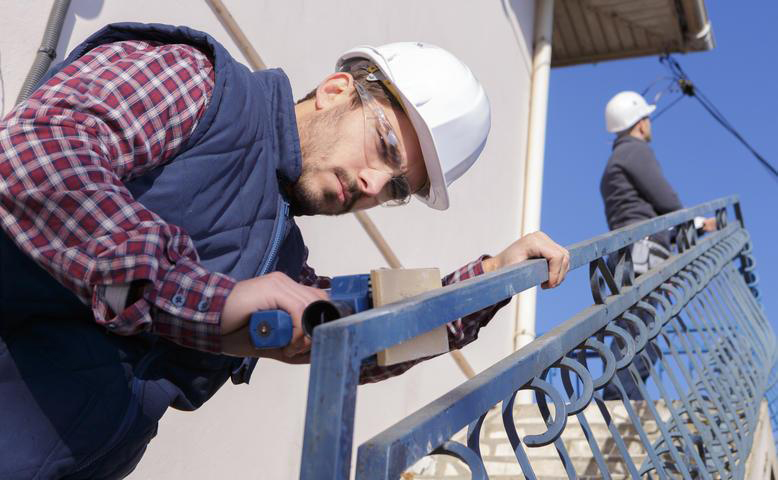
a. Firstly, fix the top and the bottom pillars, then draw a straight line between the top of the two pillars and place the middle pillar on the step (noted that the pillar can be moved back and forth to maintain at the same height of the line), markdown the fixing holes on the pillars and drill the holes to fix the pillars.
b. If the construction is based on a completed brick or marble floor, use a glass drill to drill the holes first. Before drilling, form a plasticine circle around the hole for water storage to drill easily. After drilling, use an impact drill with a diameter of 12 mm to drill holes. If it is a wooden floor, just fix the pillar with self-tapping screws.
c. Cable railing: insert the wire into a thin water pipe, bend the position where it is needed by hand, which is more effortless. If the wire is greater than 12mm in diameter, it should be bent by a wire bending equipment, locate the bending point and bend the wire before threading. After that, put the wire in the wiring hole, place it well and then fix the wiring hole on the pillar.
d. Handrail installation: locate the bending point, wrap to heat it by a heat bending blanket for 15-20 minutes, then bend the handrail when it becomes soft. If the heat blending blanket is long enough, it can be placed on the pillar without touching the handrail. On the other hand, applying cold compress on handrail by preparing a warm towel in advance, rub the handrail along the bend until the handrail is fully shaped. Moreover, this approach is also applicable in clearing up the scratch that is caused by transportation and daily usage.
e. Lastly, install the handrail plug and wire plug, screw and tighten the screw securely.

1. Dimensions of stair handrail
a. The indoor handrail height, measured vertically from the edge of the tread shall be not less than 0.9m; the height of the outdoor stair handrail shall be more than 1.05m.

b. When the stairwell width is greater than 0.20m, the width of the vertical element of the handrail shall be greater than 0.11m to prevent the child from falling.

c. The stair landing in clear width shall not be less than the width of stairs and in the meantime, the former shall be greater than 1.10m in net width.
d. The width of the stairs is regulated by building codes. On any occasion, stairs should meet the requirement of the fire evacuation. As for stairs in the public buildings, the width is usually greater than the regular standard. Besides, the number of handrails is based on the width of the stairs. For example, in normal cases, stairs should have handrails on at least one side; for stair serving three users, handrails must be provided on both sides of the stair; for four simultaneous persons walking on the stair, the stair should have an extra intermediate handrail.
2. The height of stair handrail
Protective stairs should be located in the balcony, veranda, indoor corridor, inner courtyard, accessible roof, indoor stair and other vacant places, which should be consistent with the following stipulations:
a. Stairs should be made of solid and endurable materials, which are capable to bear the prescriptive load;
b. When the airing altitude is under 24m, the height of stair handrails should be greater than 1.05m. When the airing altitude reaches 24m or above, including middle or high rise residents, the minimal height of stair handrails should be not less than 1.10m;

c. There shall not have openings if the stairs are 0.10m from the walking surface.
d. In public places that allow children to enter, such as schools, buildings for culture and entertainment, commercial buildings, sports buildings, and gardens, the stair handrails should be constructed to prevent the youth and kids from falling. If using vertical elements to build the stair guardrails, the gap should be less than 0.11m.

e. The standard height of the indoor stair handrail is 90cm, but it can be changed according to the actual circumstances. If the length of stair surpasses 5m, the stair handrail height shall be increased to 100cm. Besides, if there is a kid at home, considering safety, the stair handrail height is better to set at 100cm.
3. The manual of stair handrail installation

a. Firstly, fix the top and the bottom pillars, then draw a straight line between the top of the two pillars and place the middle pillar on the step (noted that the pillar can be moved back and forth to maintain at the same height of the line), markdown the fixing holes on the pillars and drill the holes to fix the pillars.
b. If the construction is based on a completed brick or marble floor, use a glass drill to drill the holes first. Before drilling, form a plasticine circle around the hole for water storage to drill easily. After drilling, use an impact drill with a diameter of 12 mm to drill holes. If it is a wooden floor, just fix the pillar with self-tapping screws.
c. Cable railing: insert the wire into a thin water pipe, bend the position where it is needed by hand, which is more effortless. If the wire is greater than 12mm in diameter, it should be bent by a wire bending equipment, locate the bending point and bend the wire before threading. After that, put the wire in the wiring hole, place it well and then fix the wiring hole on the pillar.
d. Handrail installation: locate the bending point, wrap to heat it by a heat bending blanket for 15-20 minutes, then bend the handrail when it becomes soft. If the heat blending blanket is long enough, it can be placed on the pillar without touching the handrail. On the other hand, applying cold compress on handrail by preparing a warm towel in advance, rub the handrail along the bend until the handrail is fully shaped. Moreover, this approach is also applicable in clearing up the scratch that is caused by transportation and daily usage.
e. Lastly, install the handrail plug and wire plug, screw and tighten the screw securely.
